
At least 17 people died after the Costa Concordia cruise ship ran aground with more than 4,000 passengers and crew on 13 January, only hours after leaving the Italian port of Civitavecchia. The maps and graphics below reveal details about the vessel and its ill-fated journey.


The Costa Concordia left Civitavecchia at about 7:33pm local time (1833 GMT). Automatic positioning data from Dutch firm QPS shows how the ship sails towards the island of Giglio - and what happens next.
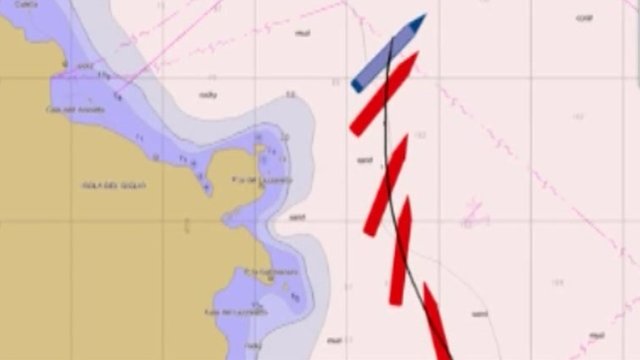
QPS reconstruction of the Concordia's final minutes
At about 9:40pm, nearly three hours after leaving port, the Costa Concordia hit a rocky outcrop as it sailed past the island of Giglio. The ship was holed on the left-hand side and began to tilt as it started taking on water.
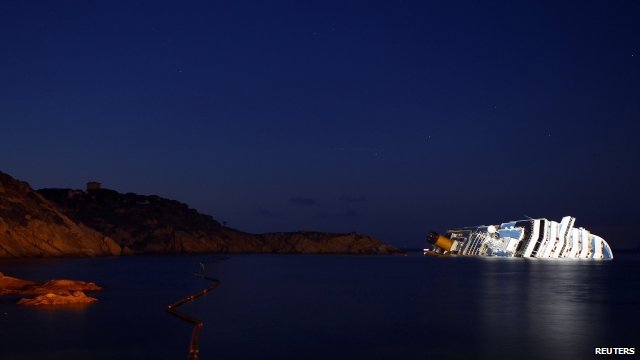
Costa Concordia crew member tells coastguard "we have a blackout"
The positioning data shows the captain tried to turn the Costa Concordia back towards the island's port soon after 10:00pm. It seems the ship then began to list in the opposite direction, possibly caused by water in the damaged hull rushing to the far side during the turn.
At 10:12pm, the coastguard called the crew after passengers contacted police on land to say the ship had experienced problems. In a recording of the conversation, the crew member can be heard saying: "We have a blackout and we are checking the conditions on board."
As the ship lay sideways on the island's rocks, the abandon ship order was given at 10:58pm, according to the official charge sheet.
Most passengers escaped in lifeboats, but evacuation efforts were hampered by the angle of the tilting ship. The coastguard launched boats and helicopters to carry stranded passengers to safety.
The captain is reported to have left the ship in a lifeboat before all the passengers had been rescued. In another conversation, recorded at12:42am, a coastguard commander ordered the captain to get back on board. He did not, and went ashore.
The rescue continued over the weekend, with the ship's safety officer, Marrico Giampietroni, being discovered and evacuated with a broken leg at 12:00pm on Sunday. A South Korean couple were also rescued.
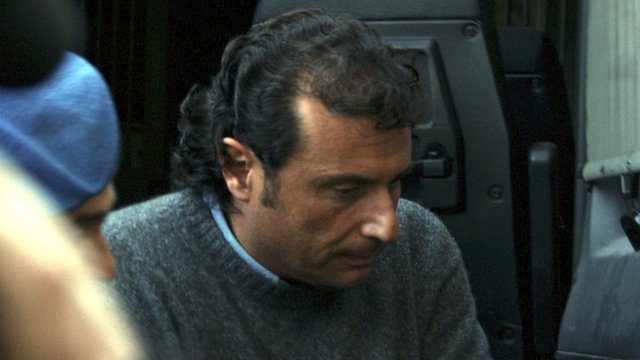
A recording has been released in which the coastguard is heard ordering the captain to 'get back on board'
Costa Concordia: What happened
Captain Francesco Schettino, now under arrest on suspicion of manslaughter, said the rocks were not marked on maps and were not detected by navigation systems. He later admitted making a navigational error, and told investigators he had "ordered the turn too late" as the ship sailed close to the island.
The ship's owners, Costa Cruises, said the captain had made an "unapproved, unauthorised" deviation in course, sailing too close to the island in order to show the ship to locals.
Crash investigation
Automatic tracking systems show the route of the Costa Concordia until it ran aground on 13 January. Data from 14 August last year shows the ship followed a similar course close to the shoreline, according to Lloyd's List Intelligence. On 6 January this year, it passed through the same strait but sailed much further from the island.
Investigators have recovered the "black box" system similar to those used by aircraft, that record voices on the bridge, as well as radar position and other data, which they hope will explain how the incident happened.
Divers have been searching the ship as it rests on the seabed in about 20m of water. The operation has been suspended a number of times as the ship has shifted position. The sea floor eventually drops to about 100m.
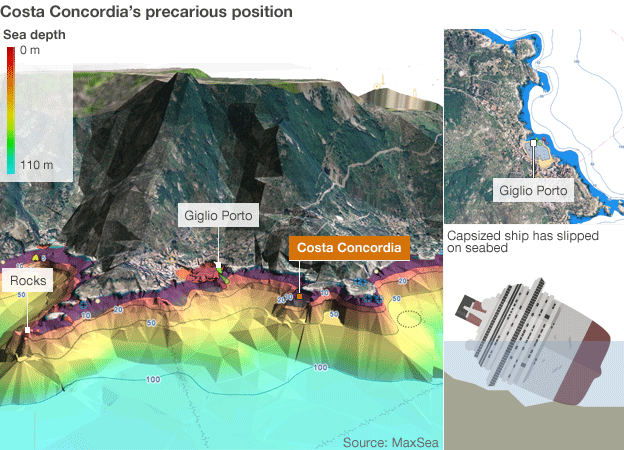
Removing the oil
Before salvage work can begin to refloat or remove the Costa Concordia, there are 2,400 tonnes of fuel in its tanks which need to be extracted.
There are between 15-20 oil tanks that need draining. They are located against the outer wall which means salvage teams can attach a valve to the outside of the ship and drill in to reach the oil, without the oil escaping - a process known as hot-tapping.
As the ship is no longer functioning, the heavy fuel oil can get thick and viscous, making it harder to pump.
To remedy this, a steam-heated element is put through the pipeline to warm the oil, making pumping much faster. The oil will be pumped to a barge and then to a larger offloading vessel.
Sucking out the oil creates a vacuum, so another hole is made lower down the tank to allow seawater to be pumped in, replacing the oil. This also ensures extracting the oil does not cause the ship to shift position on the seabed.
Costa Concordia: What happened
Captain Francesco Schettino, now under arrest on suspicion of manslaughter, said the rocks were not marked on maps and were not detected by navigation systems. He later admitted making a navigational error, and told investigators he had "ordered the turn too late" as the ship sailed close to the island.
The ship's owners, Costa Cruises, said the captain had made an "unapproved, unauthorised" deviation in course, sailing too close to the island in order to show the ship to locals.
Crash investigation
Automatic tracking systems show the route of the Costa Concordia until it ran aground on 13 January. Data from 14 August last year shows the ship followed a similar course close to the shoreline, according to Lloyd's List Intelligence. On 6 January this year, it passed through the same strait but sailed much further from the island.
Investigators have recovered the "black box" system similar to those used by aircraft, that record voices on the bridge, as well as radar position and other data, which they hope will explain how the incident happened.
Divers have been searching the ship as it rests on the seabed in about 20m of water. The operation has been suspended a number of times as the ship has shifted position. The sea floor eventually drops to about 100m.
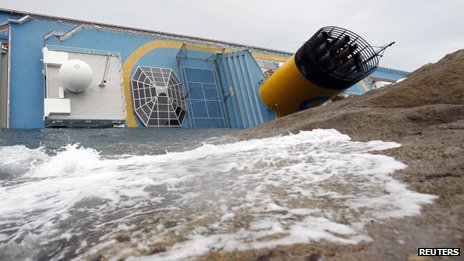
The super-sized cruise ship Costa Concordia is half-submerged off Italy's Tuscan coast. So what will happen to the 450-million-euro (£372m) vessel?
As divers desperately scour the 1,500 cabins for signs of life, and hopes fade of finding more people alive, thoughts have turned to rescuing the ship.
Maritime salvage specialists already have staff at the scene assessing the Can a stricken cruise ship be salvaged?options.
"Only a few salvage companies could handle a job of this magnitude," says Mike Lacey, secretary general of the International Salvage Union.
"This goes on all the time but you don't hear about it because they aren't as spectacular as this one. But there's always a ship in trouble somewhere."
So what might be the fate of the Costa Concordia in the weeks, months and possibly years ahead?
Search and rescue has priority, that's always the case, says Mr Lacey, but other underwater inspections will be under way to see what damage the rocks have wreaked to the hull.
"You can see the terrific damage above the waterline but who knows what has happened to the starboard side of the hull?
"You can't put a ship like that on the rocks without doing damage."
Costa sinking: How it happened
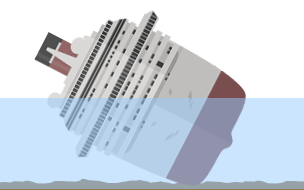
Although there is no evidence that any of the ship's 2,000 tonnes of diesel oil has yet leaked, there are fears that if it slips on the rocks, one of the 17 tanks could breach and cause a spill.
The island's mayor has warned of an "ecological time-bomb", and anti-spill booms encircle the ship to minimise the threat of an environmental disaster.
A Dutch company specialising in salvage operations, Smit, has been asked to remove the fuel.
Its operations manager Kees van Essen said the company was confident the fuel could be safely extracted through a system of pumps and valves which vacuum the oil out to waiting tanks.
The process, involving engineers and divers, would take two to four weeks.
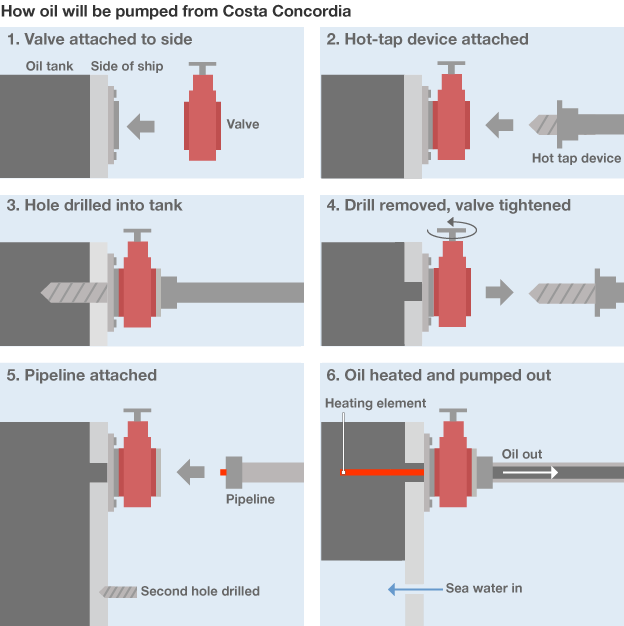
“Start Quote
It may be the ship isn't salvageable and it isn't possible to right it, patch it up and send it on its way”
Dawn GormanInternational Tug & OSV
A statement by the parent company, Costa Crociere, said the ship could be lifted with "balls of air" and once floating, towed away by tugs.
The process is called parbuckling, an old-fashioned way to get ships upright, says Mr Lacey. This involves barges with huge winches slowly heaving the ship into position, bit by bit.
"You need a huge turning movement - the power you need to apply to pull the thing into the vertical position. It's simple physics.
"There was a similar operation on the Herald of Free Enterprise in 1987 but that ship was a quarter of the size."
Air bags could be placed under the starboard side by divers and then inflated to help push it upright, he adds, but those alone would not have sufficient force.

There is a huge amount of food on the ship, which will smell if not removed.
And the passengers' belongings in cabins on the port side will also need to be recovered, says Mr Lacey.
Much of what is inside the ship and below the sea level is likely to be written off, he says.
Some of it is has already floated to the surface.
"A lot could be replaced quite easily but the bigger damage is to the bottom of the ship - the machinery and electronic systems."
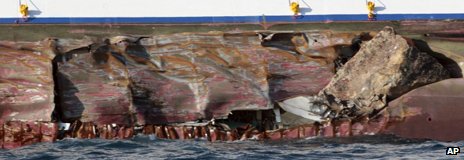 The
hole in the hull on the port side is 48.8m (160ft) wide
The
hole in the hull on the port side is 48.8m (160ft) wide
"It's possible, with small areas of damage, to prefabricate a [steel] patch and put it into place," says Dawn Gorman, editor of the magazine, International Tug & OSV.
"But whether that's possible with damage this size, we don't know."
If it could be patched up, the next step would be to pump the water out and stabilise it, a very lengthy process, says Ms Gorman.
"But there's no point pumping the water out unless the damage has been patched up, and that's a big hole.
What happened to other ships?
1987: Car ferry Herald of Free Enterprise was parbuckled upright and towed away but scrapped
2002: Car ferry Tricolor cut up after collision
2007: Container ship MSC Napoli broken up after difficulty in the English Channel
2012: Container ship Rena broke up itself after three months aground near New Zealand
"It may be the ship isn't salvageable and it isn't possible to right it, patch it up and send it on its way, because fundamental damage has been done."
Last month the container ship Rena broke in two near New Zealand, after constant battering by the ocean, three months after it ran aground.
That's unlikely to happen to the Costa Concordia, says Mr Lacey.
"Rena was in a very exposed position so she got smashed up, but you won't get metal fatigue in this case. There isn't a huge fetch [the length of sea over which a wind blows] so she won't start rusting any time soon."
Once upright, towing the ship using tugboats is very straightforward, and means it could be taken away for full repairs.
The Costa Concordia might be large for cruise ships, but not compared to some oil tankers and bulk carriers.
But given the damage, it may just be cut up and taken away in parts for scrap. The insurer has to assess the cost of repairs and the cost of getting it into a position to repair it.
